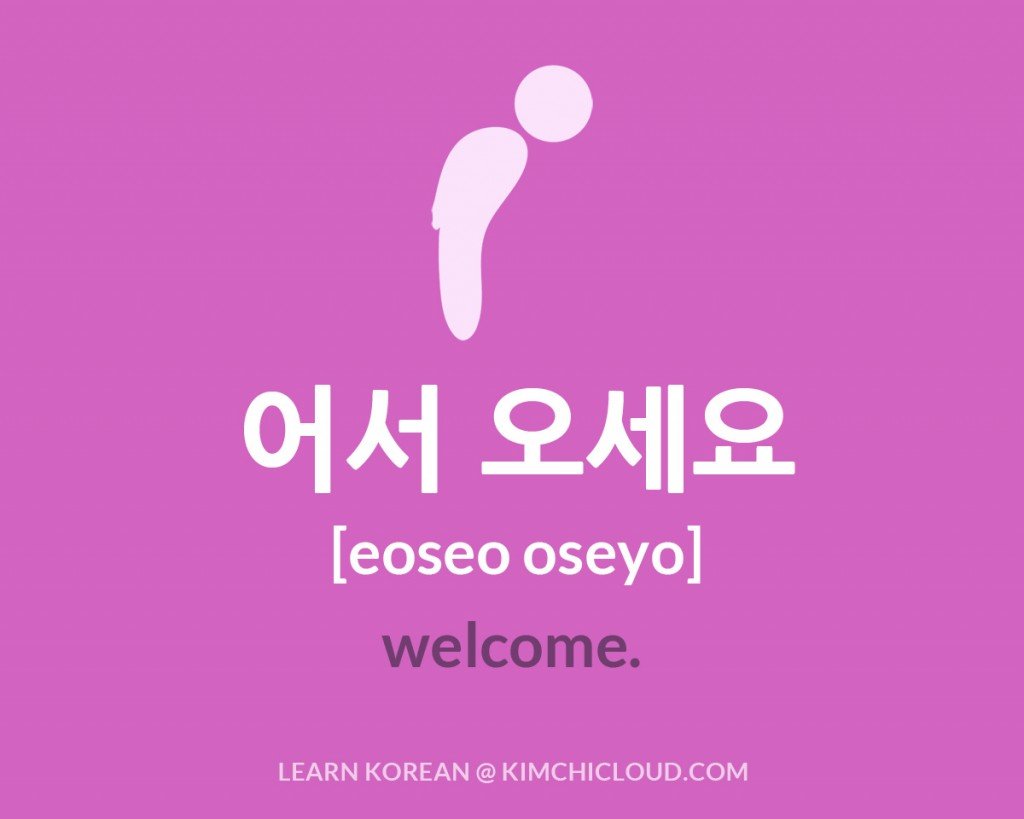어서오세요 – How to Say Welcome in Korean

Welcome in Korean
In this lesson we will take a look at how to say “Welcome” in Korean. There are mainly two ways to say this, and if you have ever walked into a store in Korea, you will most definitely have heard one of them. However, if you were to look up the word “welcome” in a Korean dictionary, you would find a different word, which is not commonly used. We will go over both in this lesson, as well as the difference between the two. Let’s start with the standard way to say it, shall we?
eoseo oseyo
In Hangul: 어서 오세요
This is the polite way to say “welcome” in Korean. If you were to translate the word somewhat literally, you would get something along the lines of “please come in”. This is the reason why you might not find it immediately in your dictionary. Since it’s a polite expression, it is appropriate to use with:
- People older than you.
- People who have higher status than you (teachers, bosses, etc.).
- People you don’t know very well.
If we break the phrase down, we find these individual components:
- eoseo (어서) – to gladly ask a person to come in (it can also mean quickly, or promptly).
- oseyo (오세요)- a polite way to say “come” (as a command). The dictionary form of is oda (오다), meaning “to come”.
As stated above, you will hear this literally almost every time you step inside a store in Korea. In clothing stores, for example, staff will say it over and over again to let people know where they are in case you need any assistance.
If all you want to know is a phrase for how to say “welcome” in Korean, then this is all you need to know. If you want to know more ways to express this, keep in reading. Otherwise, we recommend you to look up more greetings and other phrases in our Everyday Korean Archive.
As always with Korean, there’s also a more formal way to say things. The formal way to say “welcome” in Korean is:
eoseo oshipshio
In Hangul: 어서 오십시오
The two expressions are very similar, as you can probably tell. The difference is the way oda (오다), to come, is conjugated. In real life, you will hear this word used quite often, as some stores like to portray a more formal image than others. For grammar nerds (you can skip this if you aren’t interested in grammar), [verbstem]+~(으)세요 is the polite way to express a command in Korean, while [verbstem]+~(으)십시오 is the formal way.
If you want to welcome your friend, you simply say:
eoseo wa
In Hangul: 어서 와
This is the informal/casual expression. The components are the same, but as with the above expression, we have conjugated the ending verb oda (오다)to the casual/informal form wa (와). You should use this with your close friends and people clearly younger than you.
We mentioned earlier that you are likely to encounter a different word in the dictionaries. That word is:
hwanyeonghamnida
In Hangul: 환영합니다
hwanyeonghamnida (환영합니다) is not commonly used in spoken Korean, but you might find it written in books, on banners, on cards, webpages among other places. It literally means “welcome”, which is why it tends to pop up in dictionaries. In other words, avoid using it when you speak.
For more common Korean phrases and expressions, please check out our Everyday Korean Archive. If you found this lesson useful, you might want to consider sharing it with your friends or giving it like! If you have any questions or comments, please leave a comment below and we will do our best to help you out.

![meaning of: ㅋㅋ - sound of giggling/laughing. ㅠㅠ / ㅜㅜ - sad/crying eyes. ㅎㅎ - [하하/haha] - Haha. ㅇㅇ - [응/ung] - Yes. ㅉㅉ - tsk tsk (that clicking sound you do with your tongue when you are displeased with someone). ㅇㅋ - [오키/oki] - Okay. ㄱㅅ - [감사/kamsa] - Thank you. ㅊㅋ - [축하 / chokha] - Congratulations. ㄴㄴ - [노노 / nono] - No. ㅈㅅ - [죄송 / joesong] - Sorry. ㄱㄷ - [기다려 / kidaryeo] - Wait. ㄱㄱ - [고고 / gogo] - Gogo. ㅂㅂ - [바이바이 / baibai] - Bye Bye. ㄷㄷ - [덜덜 / deoldeol] - I'm shivering. ㅅㄱ - [수고 / sugo] - Well done / Good job](https://kimchicloud.com/wp-content/uploads/2015/03/korean-texting-slang9-60x57.jpg)


